advertisement
Slack vs. Teams: Which is best for your business?
Chat-based collaboration software is a must-have in today’s business environment, with Slack and Microsoft Teams the two leading options for…
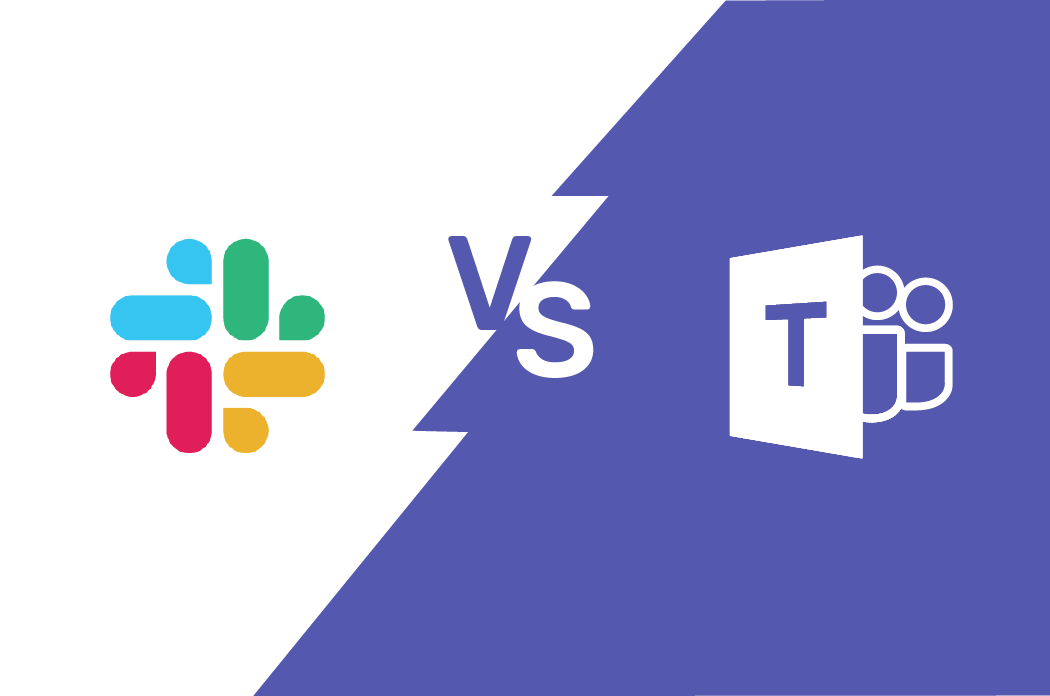
At the same time, Microsoft executive Jared Spataro was recently quoted as saying that the company considers Teams to be as important to its future as Windows was to its past. Indeed, Microsoft has been touting Teams’ growing user numbers with great fanfare, citing 20 million active daily users in November, compared with Slack’s 12 million. For its part, Slack has questioned Microsoft’s figures, saying its own users are more actively engaged.
The winner of this competition? You. There are two excellent collaboration platforms from which to choose, both of which are constantly getting better as new features are added. But making that choice isn’t easy. In fact, some enterprises have effectively chosen not to choose.
advertisement
To make your decision a little easier, I’ve compared Slack and Teams for enterprises in six categories: interface and usability; integrations; additional noteworthy differences; mobile apps; security, compliance and enterprise management; and pricing. Here’s what I found.
Slack vs. Teams: Interface and usability
Look and feel: Both the Slack and Teams desktop apps have easily navigated interfaces, with messaging front and center as the focus. There are some stylistic differences. Slack has a freeform, looser feel that I like but some might consider a tad chaotic. Teams has a vaguely corporate look, which feels more streamlined but generic.
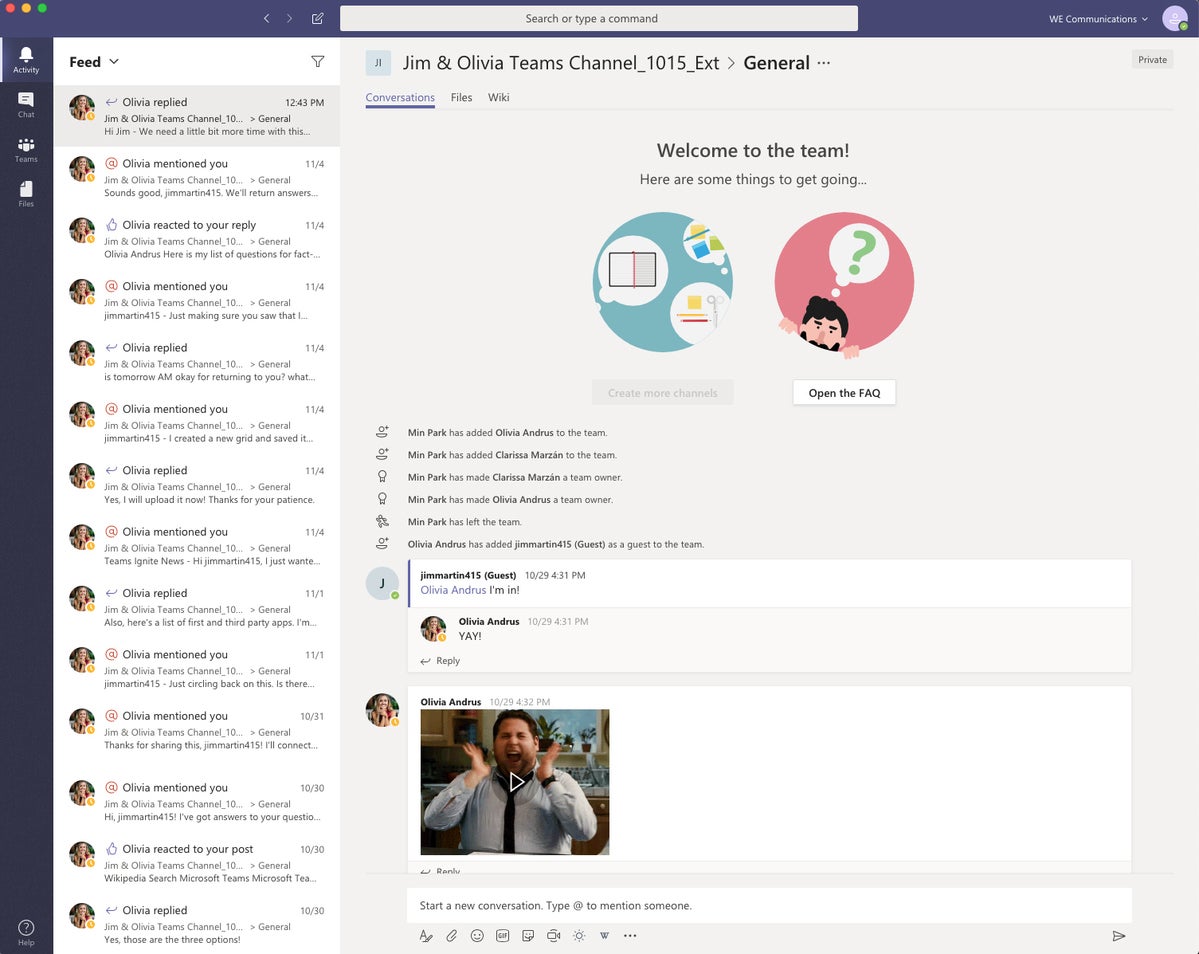 IDG
IDGOf the two, Slack offers more customization options, with 10 different ways to tweak the sidebar’s look. By comparison, Teams offers only three customization options: default (light), dark, and high contrast for the visually impaired.
advertisement
Navigation: Both clients offer their main navigation in sidebars on the left-hand side. Teams navigation is more focused on teams, while Slack puts more emphasis on channels, work areas that users create around projects, topics, or teams.
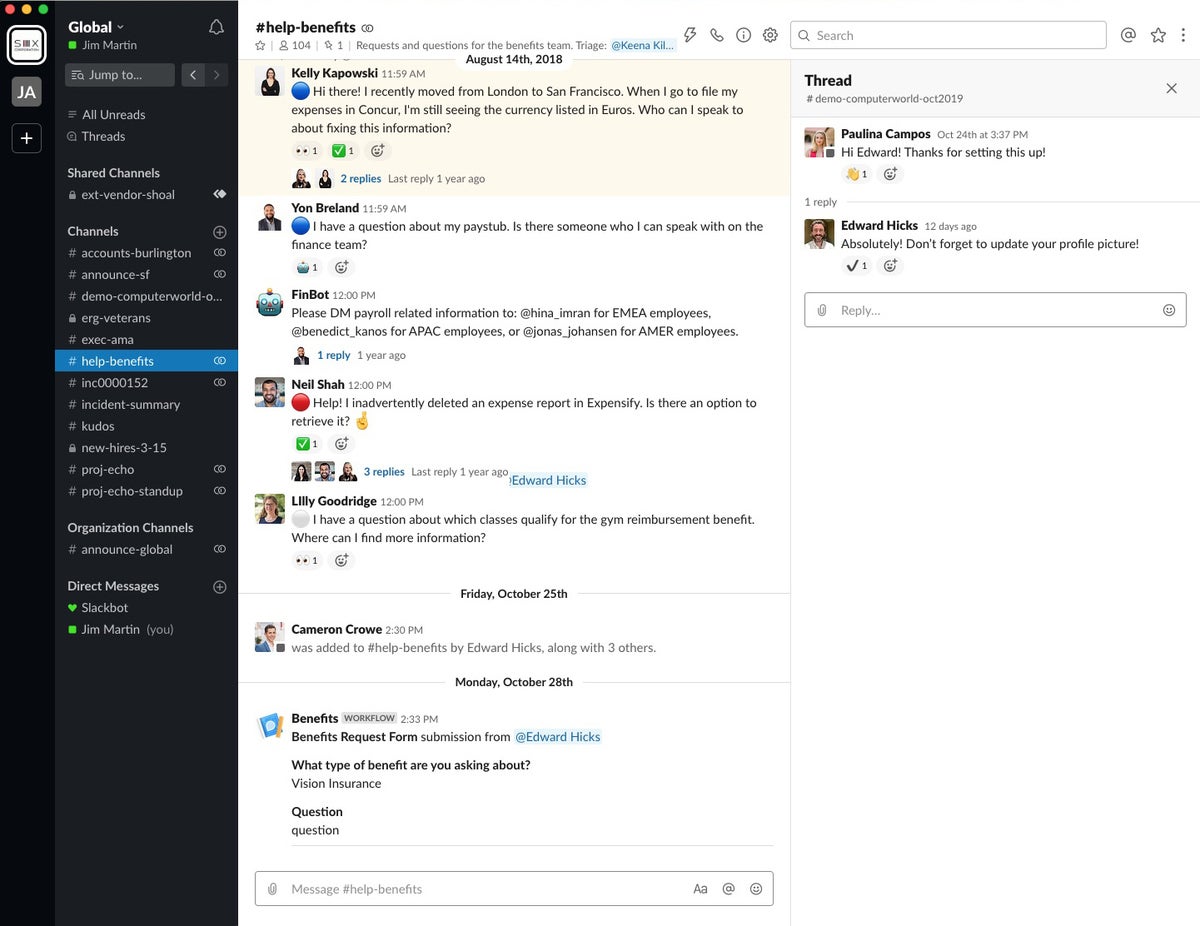 SLACK
SLACKThe Teams sidebar includes icons for Activity, Chat, Teams, Files and, depending on how the organization sets it up, possibly Calendar, Calls and more. The Activity dashboard provides an at-a-glance overview of everything happening in your organization. You can filter the feed by ‘My Activity’ to see conversations in which you’ve been involved, a handy way to get focused. Teams’ top-line navigation includes tabs for Conversations, Files, and a team wiki.
Slack’s sidebar includes links to channels, threads, direct messages (DMs), drafts (which is helpful for finishing messages you may have forgotten about), as well as ‘All Unreads,’ which displays all unread messages in one convenient feed. The automated Slackbot, a chatbot for help, is also easily available in the sidebar. Speaking of which…
advertisement
In-app help: Teams offers a Help icon at the bottom of the sidebar with links to Topics, Training, and What’s New. There are some nice touches here. From the Topics tab, for instance, you can click a link to a Microsoft web page to sign up for a free, live, online Teams training class.
But Slackbot, an in-app chatbot, gets my vote. It’s dead-simple to use. Just type a DM to Slackbot with a keyword or fully formed question and you’ll (usually) get exactly what you need within seconds. In dozens of queries, Slackbot only missed the mark once or twice in its answer.
Search: Both offer great search capabilities. But Slack search feels more robust to me, especially if you’re used to fine-tuning Gmail search results, as I am. For example, in Slack you can search using modifiers such as from:@username or before:10/31/2019.
Messaging and chat: Communication via messaging is clearly core to each product, and both do a fine job in this department. There are some differentiating features to consider:
Both offer some text formatting capabilities when writing messages. (To see these options in Slack, click the “Aa” icon at the right of the text-entry box; in Teams, click the icon that looks like an “A” with a paintbrush over it.) But Teams provides a more word processing-like experience, with the abilities to choose font color and size, insert a table, apply paragraph styles, and such. That may be overkill for some, but I appreciate these options.
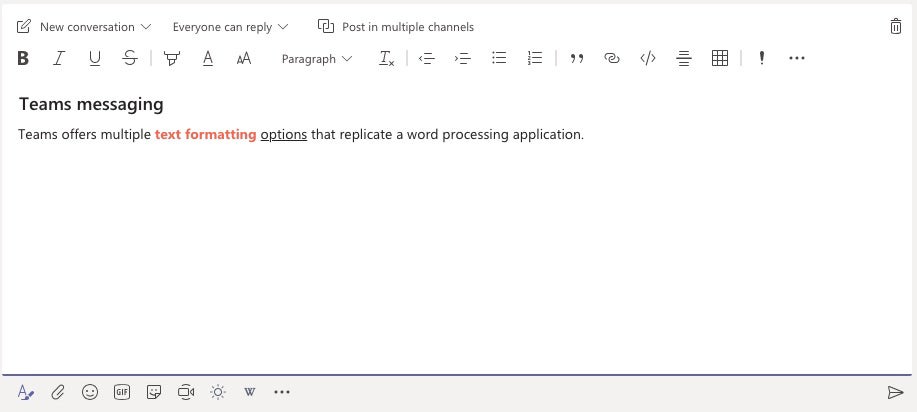 IDG
IDGBoth enable you to enliven messages with emojis. Teams offers additional options natively, such as integration with GIPHY for animated GIFs, though you can add GIFs to Slack through an app integration.
Both offer various levels of voice and video chat, natively and via app integrations, from within the apps. With Slack, your best bets for the most functionalities are via integrations with Zoom, Webex, Google Hangouts, or others. With Teams, you’ve also got multiple options, including the ability to use Microsoft’s cloud-based Phone System to call people outside your organization. Depending upon how Slack or Teams is configured, you can record video chats and calls as well as get transcriptions.
 SLACK
SLACKBoth frequently roll out new features, often for a similar purpose but implemented differently. For example, Slack’s recently added Reacji Channeler app lets you copy messages from one public channel to another using only an emoji reaction, known as a “reacji.” It’s a cool trick that shows creative thinking from Slack developers. On the other hand, Teams recently added cross-channel posting, which lets you simultaneously post one message in multiple channels. Both are useful; Slack’s is just a bit more fun.
Notifications: Given how intrusive these apps can become if you let them, it’s imperative to control when, how, and how frequently they notify you.
Teams gives you granular controls over what you’re notified about — chats, mentions, replies, likes and reactions, missed calls, voicemails, and so forth. You can choose how you’d like to receive these notifications, such as via banner and email in the desktop app.
Slack doesn’t provide quite as many notification options. But I appreciate the ability to use different notification settings for a mobile device vs. your desktop and to be notified whenever someone uses a keyword you specify.
As for much-needed Do Not Disturb controls, Slack excels. You can silence incoming notifications for 30 minutes; 1, 2 or 4 hours; until tomorrow; until next week; or for a custom time period. But I also like that Teams lets you specify quiet hours to mute all notifications as well as designate quiet days, such as Sundays. These controls are available only in the Teams mobile app.
With Slack, you can automatically push notifications to mobile when you’ve been inactive on the desktop client for a specified period of time, from ‘as soon as I’m inactive’ to ‘after I’ve been inactive for 30 minutes.’ Teams is a bit more limited. Your two choices are to receive mobile notifications when you’re not active on desktop (after three minutes) or to always receive mobile notifications. This control is also available only in the Teams mobile app.
Top takeaway: For me, the standouts in the interface and usability category are Slackbot’s in-app help, Slack’s customization options, and Teams’ message formatting. So, I’m giving Slack a slight edge over Teams here.
Slack vs. Teams: Integrations
While each product does a lot on its own, Slack and Teams both rely upon integrations with other apps and services to extend their functionality. There are some noteworthy differences to consider, particularly regarding integration with productivity suites.
Teams is the winner for Office 365 app integration. Not surprisingly, Teams lets you integrate apps from the cloud-based Microsoft Office 365 suite. While working in Teams, you have full creating, editing and formatting capabilities in Word, Excel, PowerPoint and others and can collaborate with colleagues on a file in real time. The deep integration with Microsoft SharePoint and Office applications worked well in my tests and makes a lot of sense for organizations embedded in Microsoft’s ecosystem.
Slack offers Microsoft integrations as well, including Outlook calendar and email, SharePoint and OneDrive, but they don’t go nearly as far as Teams’ Office 365 integrations.
Slack is the pick for G Suite integration. On the other hand, Slack provides integrations with Google’s G Suite apps; Teams offers integration only with Google Drive, not with G Suite (including Gmail), which is an arch competitor to Office 365. With the G Suite app for Slack, you can access, share, create, reply to comments, and resolve actions on files from within Slack. Editing the file happens in the relevant G Suite app.
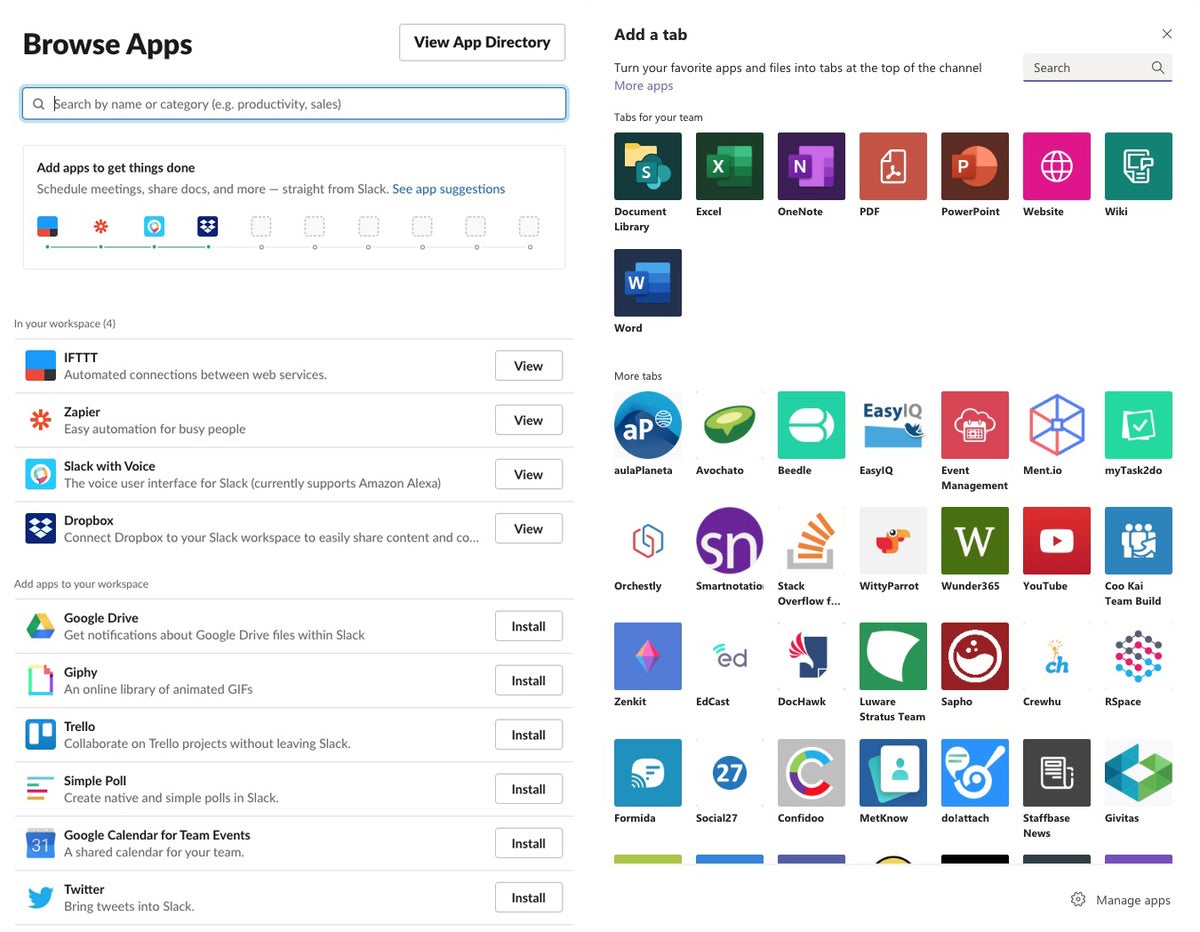 IDG
IDGSlack offers way more third-party app integrations. Slack (launched in 2013) had a running start on Teams (which debuted in 2017), and it shows in terms of integrations. As of this nanosecond in time, Slack integrates with 2,000+ commercial, third-party apps compared to about 250 for Teams.
Both Slack and Microsoft Teams enable customers to build their own custom apps and integrations. According to Slack, 500,000 custom apps built by customers were used in a typical week during September 2019. Microsoft enables custom apps and integrations via its Power Platform developer tools.
Top takeaways: If you’re a ‘best-in-breed’ believer who wants the right tool for the job and doesn’t like going too deeply into any one vendor’s ecosystem, Slack is your best choice. That said, Teams’ integration with Office 365 apps is excellent and should be strongly considered if you’re a Microsoft shop.
Slack vs. Teams: Additional noteworthy differentiators
Slack and Teams developers are hard at work, perpetually cooking up new features to set their product apart. Thus, a complete list of notable differentiators would be too long to include. But here are some that impressed me.
Slack’s shared channels feature makes it super-easy to connect your company’s Slack workspaces to an external partner’s Slack workspace for seamless collaboration. Participants from outside your organization are clearly identifiable by their company logo embedded in their profile picture.
With Teams, it’s more complicated to chat with people outside your organization. You can add external access or guest access to outside parties. External access lets you communicate via voice or video chat and set up meetings with other organizations that use Skype for Business or Skype (support for the latter is said to be coming in 2020). Guest access lets you add an individual outside your domain to channels as well as communicate with them via calls or files.
Slack can scale broadly. Slack can support an unlimited number of users per organization and channels per workspace and more than 100,000 users on a channel. By comparison, Teams supports a maximum of 5,000 users per organization; 200 channels per team; and 5,000 users on a channel.
Teams offers capabilities designed to help firstline workers who handle service- and task-oriented duties in retail, hospitality, travel and manufacturing. The features are designed to make it easy for workers to clock in and out on their mobile devices, share their location and perform other tasks specific to their duties. Slack isn’t far behind, offering app integrations for firstline workers such as Attendance Bot, which helps manage time tracking, tracking breaks and lunches, hourly bill syncing, employee shift planning and such.
Teams offers an integrated Wiki feature for notes, which is helpful for pooling knowledge from team members. Slack offers team knowledge gathering through app integrations such as Guru, a bot for capturing and sharing information.
Top takeaway: In my view, Slack has a few more notable differentiators than Teams, such as shared channels.
Slack vs. Teams: Mobile apps
Some desktop applications shed features and capabilities in their mobile OS versions. In my tests, that’s not the case with either Teams or Slack. Both replicate the desktop experience reasonably well, though Slack does a better job maintaining the desktop client’s visual pizzazz.
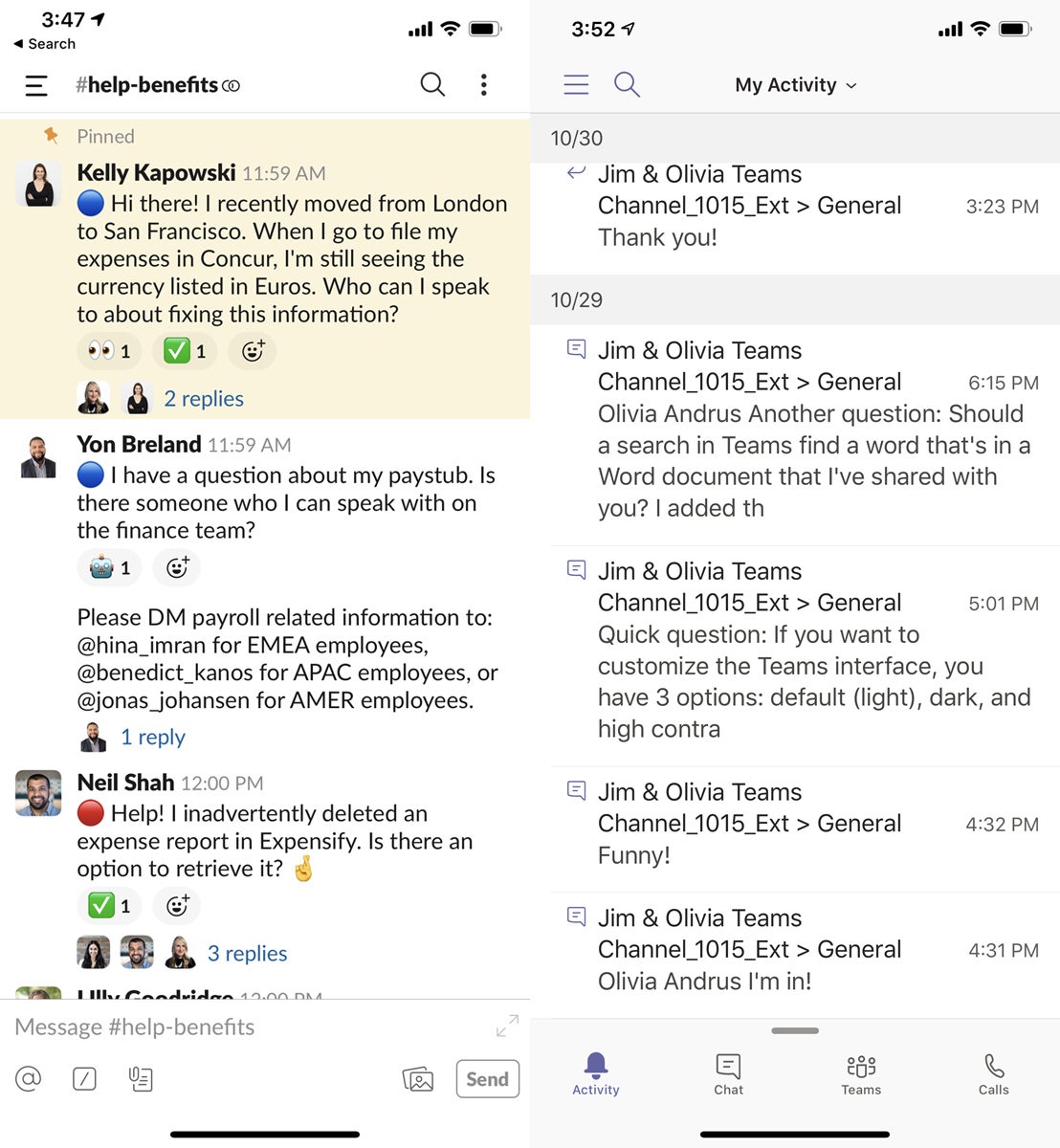 IDG
IDGMost importantly, you shouldn’t have to learn a different way to do things in the mobile versions of Slack or Teams, and you don’t — unlike the experience you get with, say, Microsoft Word’s desktop client vs. its mobile app.
There are some interface differences that are designed to accommodate a smaller, touch-enabled mobile device screen, of course. If you mouse over a message in Slack’s desktop client, for instance, you can add a reaction, start a thread, share the message and so on. On mobile, you tap and hold down a message to perform those same actions.
Top takeaway: This category is a tie, with a slight nod to Slack for maintaining a more consistent look and feel across devices.
Slack vs. Teams: Security, compliance and enterprise management
In terms of security, compliance and enterprise management, there are lingering assumptions that Teams is the stronger choice given Microsoft’s much longer tenure in the enterprise. And if you’re an enterprise user of Office 365 apps, you are getting top-notch security, compliance and enterprise management controls with Teams — especially if you’re a Microsoft 365 subscriber.
But these days, Slack and Teams both cover many of the expected security and compliance basics, though in some cases the features are native to the platform and in others, they’re through integrations. For example, both apps encrypt data in transit and at rest and support region-based data residency; data loss prevention; eDiscovery and legal hold; mobile application management; single sign-on; and the ability to require two-factor authentication — although some of those features are available only with higher-tier plans.
Slack is upping its game in this area, too. Earlier this year, the company introduced its Enterprise Key Management, an add-on tool for its top-tier Slack Enterprise Grid plan. EKM enables organizations to use their own keys for encrypting messages and files shared within Slack. Also for Enterprise Grid, Slack recently added mobile security features that let admins configure Slack to require additional layers of security after single sign-on, such as Face ID and Touch ID on iOS.
Top takeaway: Slack offers what most small to midsize businesses (SMBs) may need in terms of security, compliance and admin controls and is continually bolstering its security posture. But Microsoft Teams — by virtue of its integration with Office 365 and Microsoft 365 — may be the best bet for enterprises.
Slack vs. Teams: Plans and pricing
Slack and Teams both offer free plans. Teams’ plan, which requires a free Microsoft account but not a paid Microsoft subscription, provides a fairly generous number of features: unlimited messages and search; support for up to 300 users; 2GB of file storage per user and 10GB of shared storage; one-to-one audio and video chat; screen sharing; unlimited app integrations; and two-factor authentication.
Slack’s free plan is more restrictive, allowing you to have up to 10,000 messages; 10 apps and integrations; one-to-one video calls; and two-factor authentication.
Beyond that, Slack plans start at US$6.67 per user per month for the Standard plan and US$12.50 per user per month for the Plus plan (both are billed annually). Pricing for the Enterprise Grid plan, which is meant for large organizations that want to support multiple interconnected workspaces, is available only by contacting Slack sales. Paid plans offer unlimited messages and integrations; screen sharing; guest access; shared channels; advanced search; and a range of security, compliance, support and administrative capabilities that expand with each tier.
Office 365 plans for small businesses and enterprises, which cost from US$5 per user per month to US$35 per user per month, add several capabilities to Teams itself — such as scheduled meetings; meeting recording; single sign-on and other security, compliance and administration features — along with the rest of the apps and services in Microsoft’s Office 365 ecosystem.
The differences in what you get with each company’s plans make an apples-to-apples comparison difficult. One way to look at pricing differences between the two is to consider what US$12.50 per user per month gets you:
- From Microsoft, you get the Office 365 Business Premium subscription, which includes Teams with all its features plus Outlook, Word, Excel, PowerPoint, SharePoint, and OneDrive for Business plus the Windows-only Publisher and Access apps for up to 300 users.
- From Slack, you get a Slack Plus subscription, which supports unlimited users and includes more Slack features than the Standard plan but less than the Enterprise Grid plan — and no productivity apps.
Top takeaways: Based on pricing, Teams has a significant advantage that could grow even stronger when the economy slows and IT spending contracts. If you’re already getting Teams included in an Office 365 subscription, you may find it difficult to justify to your bosses why the company should also pay for Slack, despite its many great features. If your organization has settled on G Suite instead of Office, however, Teams’ cost advantage disappears.
Slack vs. Teams: Feature comparison
Final recommendations
As I mentioned earlier, some companies use both Slack and Teams. But that approach adds complexity and cost and isn’t a viable option for most organizations. If that’s true for you, here are my recommendations:
When it comes down to it, Slack and Teams are more alike than they differ. In many cases, both offer some version of the same features, either natively or through an app integration. And if one is missing a feature you need, chances are it will be added sooner than later, given the heated rivalry. The one thing you should pay attention to is: how much will an integrated service add to your total cost?
If you’re already deep in the Office 365 world, Teams is a great choice. If nothing else, give Teams a sustained trial before deciding.
That said, a growing subset of Office 365 customers are using Slack. According to data from access management platform Okta, 31% of its customers that use Office 365 also use Slack, up from 28% in October 2018 and 19% in 2017. And of Slack’s top 50 customers, 74% are also Office 365 customers, according to data from Slack’s analytics team.
If you’re not beholden to Microsoft, you want to avoid vendor lock-in, or you’re a G Suite shop, Slack is the way to go. It’s an excellent choice for those who prefer a ‘best-in-breed’ technology stack, and it’s particularly popular among SMBs and tech companies.